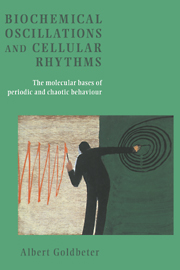Book contents
- Frontmatter
- Contents
- Foreword to the English edition by Michael Berridge
- Foreword to the French edition by Ilya Prigogin
- Preface
- 1 Introduction
- Part I Glycolytic oscillations
- Part II From simple to complex oscillatory behaviour
- Part III Oscillations of cAMP in Dictyostelium cells
- Part IV From cAMP signalling in Dictyostelium to pulsatile hormone secretion
- Part V Calcium oscillations
- Part VI The mitotic oscillator
- Part VII Circadian rhythms
- References
- Index
Foreword to the English edition by Michael Berridge
Published online by Cambridge University Press: 26 February 2010
- Frontmatter
- Contents
- Foreword to the English edition by Michael Berridge
- Foreword to the French edition by Ilya Prigogin
- Preface
- 1 Introduction
- Part I Glycolytic oscillations
- Part II From simple to complex oscillatory behaviour
- Part III Oscillations of cAMP in Dictyostelium cells
- Part IV From cAMP signalling in Dictyostelium to pulsatile hormone secretion
- Part V Calcium oscillations
- Part VI The mitotic oscillator
- Part VII Circadian rhythms
- References
- Index
Summary
All life is rhythmical. Just to feel the human pulse is to marvel at how the heart beats out its regular rhythm. It is a sobering thought that, for the whole of our lives, a small group of pacemaker cells dutifully send out a signal every second or so to drive each heart beat. For someone living to 70 years with a heart rate of 60 beats/minute, we can calculate that this oscillator will have faithfully transmitted well over two billion beats! Such rhythmicity occurs in many other cell types especially when they are being stimulated. For example, a liver cell generates regular pulses of calcium when it responds to the hormones that signal the breakdown of glycogen. Another striking example is the burst of spikes that occur in mammalian eggs following fertilization. In humans, as in other mammals, the egg remains quiescent for many years until it is coaxed into life by the train of spikes triggered by the arrival and attachment of the sperm. Exactly the same mechanisms are employed to generate the calcium spikes observed in liver cells and eggs. On a separate time scale, we are all aware of our circadian clock through its ability to drive our diurnal sleep-wake cycle. The strength of this circadian oscillator is all too obvious to jet travellers as they cross time zones.
- Type
- Chapter
- Information
- Biochemical Oscillations and Cellular RhythmsThe Molecular Bases of Periodic and Chaotic Behaviour, pp. xv - xviiiPublisher: Cambridge University PressPrint publication year: 1996

